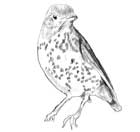The Round Hill Society
The home site of the Round Hill Society, a community group of the residents of Round Hill in Brighton, England. The site contains information about the area, latest news and reflections on life in Round Hill.
Song thrushes and slow-worms
Spare a thought for your feathered, furry, and fluttering friends…..
 I woke up this morning to the bleak sound of chainsaw working its way through a tall evergreen tree. For the last two years I have watched song thrushes nesting in the very same.
I woke up this morning to the bleak sound of chainsaw working its way through a tall evergreen tree. For the last two years I have watched song thrushes nesting in the very same.
Our seasons are changing and songbirds are nesting earlier and earlier. It is really important that they can find both food and shelter in these early spring days. Evergreen bushes and trees can provide a vital refuge for birds trying to nest when all other cover is bare.
If you are considering a spot of gardening as the days lengthen and the sun begins to shine, it is easy to forget the wildlife your garden may be harbouring.
Some species may be hibernating: hedgehogs spend their winters under piles of garden rubbish, in compost heaps, under sheds etc; slow worms hibernate in compost heaps and in flower beds in slow worm ‘nests’.
Even some butterflies overwinter in this country! So don’t be surprised by dazed looking tortoiseshell butterflies appearing from sheds and outhouses.
In the spring, birds may be making nests in trees and will abandon their eggs and young if they become frightened.
We are lucky enough to harbour at least two endangered/protected species in the Round Hill area. The first is the song thrush and the second are slow worms (which are lizards, not snakes!).
Both of these species are protected by the 1981 Countryside and Wildlife act. This law makes it an offence to injure or kill any protected bird or animal. It also criminalises the disturbance of bird nests, whether occupied or vacant. Under the law it is also essential to avoid disturbing any other protected animal when residing in nests, burrows and garden hiding holes!
If you are interested in learning more about how you can help our local wildlife, the following websites include information on helping all sorts of wildlife in your garden.
www.wildaboutgardens.org
www.rspb.org.uk/gardens
It can also be useful for sightings of protected species to be recorded. The Sussex Biodiversity records centre has information on how this can be done at
www.sxbrc.org.uk (bottom right, under ‘Get Involved’).
Enjoy the spring!
This page was last updated by Ted on 20-Nov-2013 I woke up this morning to the bleak sound of chainsaw working its way through a tall evergreen tree. For the last two years I have watched song thrushes nesting in the very same.
I woke up this morning to the bleak sound of chainsaw working its way through a tall evergreen tree. For the last two years I have watched song thrushes nesting in the very same.
Our seasons are changing and songbirds are nesting earlier and earlier. It is really important that they can find both food and shelter in these early spring days. Evergreen bushes and trees can provide a vital refuge for birds trying to nest when all other cover is bare.
If you are considering a spot of gardening as the days lengthen and the sun begins to shine, it is easy to forget the wildlife your garden may be harbouring.
Some species may be hibernating: hedgehogs spend their winters under piles of garden rubbish, in compost heaps, under sheds etc; slow worms hibernate in compost heaps and in flower beds in slow worm ‘nests’.
Even some butterflies overwinter in this country! So don’t be surprised by dazed looking tortoiseshell butterflies appearing from sheds and outhouses.
In the spring, birds may be making nests in trees and will abandon their eggs and young if they become frightened.
We are lucky enough to harbour at least two endangered/protected species in the Round Hill area. The first is the song thrush and the second are slow worms (which are lizards, not snakes!).
Both of these species are protected by the 1981 Countryside and Wildlife act. This law makes it an offence to injure or kill any protected bird or animal. It also criminalises the disturbance of bird nests, whether occupied or vacant. Under the law it is also essential to avoid disturbing any other protected animal when residing in nests, burrows and garden hiding holes!
If you are interested in learning more about how you can help our local wildlife, the following websites include information on helping all sorts of wildlife in your garden.
www.wildaboutgardens.org
www.rspb.org.uk/gardens
It can also be useful for sightings of protected species to be recorded. The Sussex Biodiversity records centre has information on how this can be done at
www.sxbrc.org.uk (bottom right, under ‘Get Involved’).
Enjoy the spring!